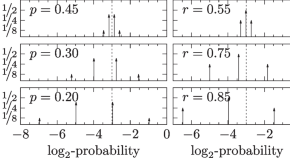
Collection
Special Issue: Physical Layer Entropy in Physically Unclonable Functions
- Submission status
- Open
- Open for submission from
- 15 December 2022
- Submission deadline
- Ongoing
Special Issue Overview:
Physically Unclonable Functions (PUFs) measure the subtle random variations in the physical structures which occur during chip fabrication to produce unique secrets for each device. In contrast to conventional secure NVM, PUF-generated secrets exhibit high resistance to physical attacks due to their nano-scale feature size and tamper-evident properties. Most silicon PUFs are cheap to manufacture, compatible with existing CMOS technologies and provide a hardware-based security profile for the device, making them attractive for a wide range of applications in consumer, medical, industrial and military IoT-based systems and for addressing counterfeiting issues in the supply chain.
The randomness of the PUF-generated secrets relies on the source of fabrication disorders in the physical structures, as well as the test structure and algorithms that extract and convert physical source of entropy into random digital secrets. However, the sources of physical random variations do not always guarantee high levels of randomness and uniqueness of PUF-generated secrets, making them vulnerable to attacks. For example, the randomness of PUF-generated responses can be undermined by spatial correlations that exist across regions of the device, which introduce bias in the generated bitstrings. Moreover, post-processing algorithms can introduce leakage that enables machine learning algorithms to easily reverse engineer properties associated with the source of entropy.
Most of the existing works propose new PUF constructions and PUF-based protocols, but works that provide in-depth analysis of entropy are limited. This special issue is focused on answering one or more of the following questions:
1. What are the true sources of entropy at the physical layer?
2. What are the sources of entropy that need to be avoided and/or eliminated, and why?
3. What are the sources of across chip/across wafer bias that act to add correlation and reduce statistical quality of the bitstrings?
4. What types of correct-by-construction design approaches can be used to optimize PUF bitstring statistical quality using, e.g., ring oscillators, across chip paths, string of conductors, etc. that maximize entropy while reducing bias effects?
5. What types of post-processing operations are beneficial to improving reliability, reducing unavoidable physic-based and reuse-based correlations while maximizing the number of bits that can be extracted, given a limited source of physical entropy?
The goal is to improve our understanding of PUFs at the physical layer, which in turn, can be leveraged to improve the security properties of PUFs and PUF-based applications.
Topics of interests for this special issue include but are not limited to:
• Maximizing the extraction of independent and reliable response bits given a limited source of physical entropy.
• Analysis and mitigations of spatial correlations and functional correlations.
• New metrics to analyze bias in PUFs at the physical level and the response level.
• Analysis of theoretical entropy bounds of weak and strong PUFs.
• Hardware-efficient post-processing methods that improve PUF entropy extraction and reliability.
• Leakage-free techniques to enhance the reliability of extracted random PUF secrets.
• Correct-by-construction design approaches that maximize entropy while reducing bias effects.
• Entropy extraction/distillation methods.
• Response generation algorithms that maximize the extraction of physical random variations.
• Physical-layer entropy analysis of fundamentally new CMOS-compatible PUF materials.
Important Dates:
Open for submissions (anticipated): December 15, 2022
Closed for submission (anticipated): Ongoing, 2023
Results of first round reviews (anticipated): June 15, 2023
Results of revised manuscripts (anticipated): Aug 15, 2023
Results of second round of reviews (anticipated): Sept 15, 2023
Publication material due (anticipated): Oct 1, 2023
Editors
-
Weinjie Che
Mexico State University, USA
-
Jim Plusquellic
The University of New Mexico, USA
-
Will Zortman
Sandia National Laboratories, USA
-
Calvin Chan
University of Colorado, USA
Articles (2 in this collection)
-

-
An Analysis of FPGA LUT Bias and Entropy for Physical Unclonable Functions
Authors (first, second and last of 7)
- Jenilee Jao
- Ian Wilcox
- Pavel B. Bochev
- Content type: OriginalPaper
- Published: 26 September 2023
- Pages: 110 - 123



